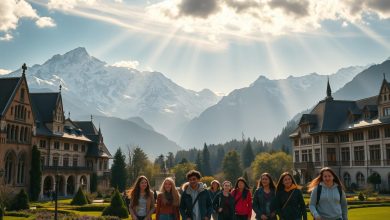Academic Excellence in Germany: Top Benefits & Strategic Advantages of Scholarships
For many international students, pursuing higher education abroad is a dream.
One destination stands out for its affordability and academic prestige. With nearly free public universities and strong support systems, it offers unmatched opportunities.
Living costs average around €934 per month, but financial aid helps ease the burden. Over 60% of public institutions charge no tuition fees. This makes academic performance more accessible for ambitious learners.
Students praise the education system, with 92% rating quality as excellent. Beyond affordability, post-study work permits allow graduates to stay for 18 months. Many secure jobs within six months, boosting career prospects.
Combining world-class learning with financial benefits, this country remains a top choice. Its strategic advantages continue to attract bright minds from around the globe.
Why Pursue Germany Scholarships for Academic Excellence?
Top-tier education meets financial support for driven students. Over a third of international learners receive funding, easing the path to good academic performance. With options like the Deutschlandstipendium offering €300 per month, financial barriers shrink.
Affordable Education in a Leading Destination
Public institutions dominate with minimal fees, while private alternatives cater to specialized programs. The cost gap is stark:
| University Type | Tuition (Yearly) | Notes |
|---|---|---|
| Public | €0–€1,500 | Administrative fees only |
| Private | €5,000–€20,000 | Includes elite programs |
Financial Support Beyond Tuition
Stipends cover living costs like housing (€400/month) and health insurance (€120/month). A mechanical engineering student shared:
“My €1,200 monthly stipend let me focus on research, not rent.”
Hidden perks include travel grants (up to €1,000) and research allowances. Over 65% of awards require a 3.0 GPA and social commitment, like leadership roles.
Funding availability grew 22% in five years, reflecting german universities‘ commitment to accessibility. For ambitious students, this ecosystem turns potential into achievement.
Government-Funded Germany Scholarships: Top Picks
Public funding opens doors for ambitious learners seeking academic growth. These initiatives combine financial stability with rigorous selection criteria, ensuring support reaches deserving candidates.
DAAD Scholarship Programs
The DAAD scholarships offer €992–€1,300 monthly, targeting postgraduate researchers. Applicants must submit research proposals and TestDaF results, with only 18% accepted annually.
New 2025 priorities include AI and renewable energy projects. A climate researcher shared:
“The stipend let me collaborate with top institutes without financial stress.”
Heinrich Böll Foundation Scholarships
Stipends here range from €812 to €1,450, varying by nationality. Dual deadlines (March/September) require proof of social commitment, like volunteer work.
Deutschlandstipendium National Program
This public-private program provides €300 monthly for two semesters. Funding covers 50% from private sponsors, 50% from federal sources.
| Program | Monthly Stipend | Duration |
|---|---|---|
| DAAD | €992–€1,300 | 12–36 months |
| Heinrich Böll | €812–€1,450 | Flexible |
| Deutschlandstipendium | €300 | 2+ semesters |
University-Specific Scholarships in Germany
Leading institutions offer tailored financial aid to attract top talent. These programs often feature lower competition than national awards, with requirements aligned to departmental priorities. German universities like Heidelberg, Hamburg, and TUM provide unique opportunities for dedicated students.
Heidelberg University HAUS Scholarships
HAUS awards range from $4,500 to $7,000 per semester, prioritizing applicants with research potential. A 15% quota ensures international representation. Review committees favor interdisciplinary projects, especially in life sciences.
University of Hamburg Merit Scholarships
Monthly funding of €930 supports high-achieving undergraduates. The “Degree Completion Grant” assists final-year students, covering thesis-related expenses. Unlike most programs, Hamburg evaluates extracurricular impact alongside grades.
TUM Linde/MDSI Master Scholarship
Technical University Munich partners with Linde Group to offer €1,000/month for data science majors. Industry mentors guide recipients, and 2025 introduces digital eligibility simulations. STEM candidates need a 3.5 GPA minimum.
| University | Endowment (€) | Average Award (€/year) |
|---|---|---|
| Heidelberg | 1.2 billion | 10,000 |
| Hamburg | 650 million | 11,160 |
| TUM | 890 million | 12,000 |
Privately Funded Scholarships for International Students
Private organizations play a crucial role in supporting global learners through specialized financial aid. These programs often target niche academic interests or ideological alignments, offering tailored funding and networking advantages.
Friedrich Ebert Foundation Scholarships
This scholarship program awards €830–€1,400 monthly, prioritizing candidates with social commitment to democratic values. Applicants must demonstrate involvement in political or social initiatives, such as climate activism or equity projects.
- Ideological alignment with social democracy principles
- Networking through alumni events and mentorship
- Case study: Funded a student-led refugee education initiative in 2024
Bayer Foundation Fellowships
Focused on STEM fields, Bayer grants €10,000 for research in medical or agricultural sciences. Recipients gain industry connections—80% secure job offers post-fellowship.
- Three sub-programs: Life Sciences, AgTech, and Medicine
- Requires a detailed project proposal and academic references
Evangelisches Studienwerk Scholarships
Offering €752/month plus a €300 study allowance, this fund supports Protestant students. Documentation of church membership is mandatory.
- Priority given to theology and social work programs
- Includes retreats and interdisciplinary workshops
Major-Specific Scholarships in Germany
Discipline-focused funding bridges the gap between talent and opportunity in key fields. Programs target high-demand areas like STEM and business, offering tailored support for outstanding academic achievers.
Hans-Peter Wild Talent Awards
This €1,000/month stipend targets MINT fields—now expanded to include robotics and quantum computing. Siemens partners with the program, prioritizing applicants with hackathon wins or patents.
- 2025 introduces quantum computing tracks
- 68% of awards historically go to male recipients
- Requires proof of research impact (e.g., published papers)
Munich Business School Awards
Business majors receive €2,850 per semester, with selection criteria emphasizing entrepreneurial projects. A 2024 recipient shared:
“The funding let me launch a sustainable startup during my studies.”
| Program | Stipend | Focus Area |
|---|---|---|
| Wild Talent | €12,000/year | MINT + Data Science |
| MBS | €5,700/year | Business Innovation |
Both programs highlight industry partnerships, ensuring students gain real-world experience alongside financial support.
Scholarships for Undergraduate Studies in Germany
Bachelor’s degree seekers can access specialized funding to support their studies. Nearly 28% of financial aid programs target undergraduates, offering tailored solutions for tuition and living costs. Unique options include dual-study funding and preparatory course stipends.
RWTH Aachen University Exchange Scholarships
This program provides €1,000 monthly plus language course coverage. Requirements include bilateral agreements between partner universities. A 2024 recipient noted:
“The stipend eased my transition into engineering studies abroad.”
Christian Wulff Scholarship
Berlin International offers 50% tuition coverage for eligible students. First-year applicants must submit proof of academic potential. Art and design candidates undergo portfolio reviews.
- Dual-study programs: Combine work placements with financial support.
- Studienkolleg aid: Covers preparatory courses for international students.
Scholarships for Postgraduate and Doctoral Research
Advanced researchers gain unparalleled support through specialized funding programs. These initiatives prioritize innovation, offering generous stipends and networking opportunities to elevate academic careers.
Humboldt Research Fellowship
The Humboldt Fellowship provides €2,700–€3,200 monthly for postdoctoral research. Applicants must complete their PhD within the last three years and secure a host institution. A 2025 recipient noted:
“The stipend enabled collaboration with top labs, accelerating my climate change study.”
Fraunhofer Institutes offer industry crossover options, while dual career services assist academic couples.
Marie Skłodowska-Curie Actions (MSCA) Postdoctoral Fellowships
MSCA awards €4,880–€7,020 monthly, including family allowances. This Horizon Europe program prioritizes open science and 2025–2027 focus areas like AI ethics. Host matching services streamline placements.
| Fellowship | Monthly Stipend (€) | Key Feature |
|---|---|---|
| Humboldt | 2,700–3,200 | Industry partnerships |
| MSCA | 4,880–7,020 | Family support included |
Both programs require proof of mobility and research impact. MSCA mandates data-sharing plans, while Humboldt emphasizes publication records.
Erasmus+ Scholarship Programs for Germany
European academic mobility reaches new heights with updated funding. The Erasmus+ program offers €850–€1,000 monthly stipends plus travel grants, supporting study abroad experiences. With a 62% acceptance rate for EU applicants, it remains a gateway to cross-cultural learning.
Eligibility and Benefits
Eligible students must enroll at accredited institutions with Erasmus charters. The program now includes 2025 partner countries like Malaysia and Chile. A biochemistry participant shared:
“The travel grant let me conduct fieldwork in three coastal ecosystems.”
Key advantages include:
- Guaranteed credit transfers through ECTS system
- Up to €15,000 for special needs support
- Crisis protocols for unstable regions
Application Process
Applications route through home universities’ international offices. Required documents include:
- Learning agreement signed by both institutions
- Proof of language proficiency (minimum B1 level)
- Motivation letter addressing cultural adaptation
Double degree seekers should apply six months early. Language course funding requires separate registration through OLS platform.
How to Choose the Right Scholarship for Your Goals
Strategic selection of financial support maximizes academic and career potential. With 43% of applicants applying to three or more awards, focusing on selection criteria and personal fit saves time. Key factors like duration (78%) and amount (92%) heavily influence decisions.
Aligning Scholarships with Academic Programs
Field-specific funding ensures resources match goals. Engineering candidates might prioritize industry-linked awards, while humanities students benefit from research grants. Tools like scholarship matching quizzes simplify the search.
A cost-benefit analysis template helps compare options. For example, combining DAAD and university awards might cover tuition and living costs. Tax implications vary—some stipends are tax-free if used for study expenses.
Evaluating Financial Coverage
Beyond stipend amounts, consider hidden costs like insurance. Public health plans average €120/month, while private options offer broader coverage. This table highlights key comparisons:
| Factor | Priority Level | Notes |
|---|---|---|
| Stipend Amount | 92% | Covers living costs |
| Duration | 78% | Matches program length |
| Insurance | 65% | Public vs. private |
Award terms directly impact academic performance. Longer funding reduces financial stress, letting students focus on research or internships. Always verify renewal policies and GPA requirements.
Key Eligibility Criteria for Germany Scholarships
Meeting scholarship criteria requires careful planning and attention to detail. Most programs prioritize good academic records and proof of language skills. Over 80% demand a minimum 2.5 GPA equivalent in the German grading system.
Academic Performance Requirements
International students often need grade conversions. A 3.0 U.S. GPA typically aligns with a 2.5 in Germany. Some programs offer conditional acceptance for borderline candidates.
Non-European qualifications require validation via the Anabin database. Mature applicants (over 30) may qualify for alternate pathways, like preparatory course stipends.
Language Proficiency Expectations
Applicants must demonstrate fluency through tests like TestDaF (4×4) or DSH-2. English-taught programs sometimes waive german language requirements but still require IELTS/TOEFL.
A 2024 awardee shared:
“Prepping for TestDaF was tough, but the scholarship made it worthwhile.”
CEFR C1 is the gold standard for humanities, while STEM fields may accept B2 with research potential.
Essential Documents for Scholarship Applications
Over 90% of rejections stem from avoidable paperwork mistakes. A 2024 study found 93% of failed applications lacked proper authentication or missed deadlines. For applicants from 15 countries, an APS certificate is mandatory—confirming academic records through the Academic Evaluation Centre.
Transcripts and Certificates
Official records must meet strict requirements. Universities often reject uncertified copies or translations. Key steps include:
- Apostille vs. Embassy Legalization: Apostilles suffice for Hague Convention countries; others need embassy stamps.
- Digital Submissions: Use PDF/A format to prevent editing and ensure long-term readability.
- Refugee Alternatives: Displaced students may submit sworn affidavits or provisional evaluations.
Creative fields like architecture require portfolios. Judges typically review 10–15 pieces, favoring process sketches over final renders.
Motivation Letters and Recommendation Letters
Admissions committees prioritize authenticity. Plagiarism checks flag submissions exceeding 15% similarity. One selection panelist noted:
“A genuine letter explaining career impact beats generic templates every time.”
Recommendation letters have waiver options if referees are unavailable. However, replacements like employer references weaken applications.
| Document Type | Common Errors | Solution |
|---|---|---|
| Transcripts | Missing seals | Request notarized copies early |
| Motivation Letter | Overused phrases | Tailor to program values |
| Recommendations | Generic praise | Provide referees with achievement bullet points |
Strong documentation reflects academic performance and attention to detail—critical for scholarship success.
Deadlines and Application Timelines
Strategic timing transforms scholarship applications from hopeful to successful. Programs like DAAD have country-specific deadlines spanning October to March, while universities often set cutoff dates in June or August. Missing these windows can delay funding by 12-18 months.
Planning Ahead for Scholarship Cycles
Top performers start preparing 18 months before their intended study period. This allows time for:
- Language test preparation (TestDaF/IELTS)
- Document authentication processes
- Multiple application rounds
Many German institutions offer rolling admission, with priority given to early applicants. The table below compares common timelines:
| Program Type | Typical Deadline | Notification Period |
|---|---|---|
| Government-funded | October–March | 3–5 months |
| University-specific | June–August | 6–8 weeks |
| Private organizations | Varies quarterly | 4–12 weeks |
Late Application Strategies
For those behind schedule, options still exist. Some universities accept deferred applications for the next intake cycle. Emergency funding sources like the Germany Academic Exchange Service occasionally have last-minute openings.
Timezone awareness proves critical—submitting at 11:59 PM CEST means midnight elsewhere. A 2024 awardee shared:
“Setting calendar alerts for CEST saved my application when traveling abroad.”
Digital tools like shared spreadsheets help track multiple scholarships simultaneously. Always confirm receipt emails to avoid technical disqualifications.
Tips for Writing a Winning Scholarship Application
Winning financial support hinges on strategic storytelling and precision. Successful applications average 3.8 revisions, reflecting the need for polished submissions. Tailoring content to selection criteria boosts approval odds significantly.
Crafting a Compelling Motivation Letter
The AIDA model (Attention, Interest, Desire, Action) structures persuasive letters. Start with a hook—like a personal challenge overcome—then align goals with the program’s values.
- Quantifiable impact: “Tutored 30+ underprivileged students, improving pass rates by 25%.”
- Cultural adaptation: Research German academic norms (e.g., directness preferred over florid prose).
- Failure resumes: Briefly show growth from setbacks, like a rejected research proposal.
Highlighting Social Commitment
72% of awarded applicants reference concrete community projects. Demonstrate social commitment through:
| Element | Example | Notes |
|---|---|---|
| Leadership | Founded a recycling initiative | Aligns with sustainability selection criteria |
| Collaboration | Volunteered at migrant centers | Shows intercultural skills |
Video submissions require neutral backgrounds and clear audio. Follow up with a thank-you email, reiterating enthusiasm—never ask for status updates prematurely.
Navigating Post-Scholarship Opportunities
Securing financial support is just the beginning—what comes next shapes long-term success. Over 85% of DAAD alumni leverage professional connections in Germany, with career services valued at €4,200 annually. This phase turns funding into lasting career momentum.
Networking and Mentorship Programs
Alumni associations offer exclusive job boards and speaker events. Industry mentorship matches students with leaders in their field, like Siemens engineers or Bayer researchers.
Startup incubators provide seed funding and co-working spaces. A 2024 green tech founder shared:
“My scholarship network helped secure our first €50,000 investment.”
Career Advancement Resources
Post-award benefits often include:
- Patent filing support: Legal aid for researchers commercializing innovations
- Continuing education discounts: 30% off executive courses at partner universities
- Dual citizenship pathways: Simplified visas for high-demand STEM graduates
These resources amplify the value of initial program awards, creating ripple effects across careers.
Common Mistakes to Avoid in Scholarship Applications
Technical oversights account for more rejections than academic shortcomings in scholarship competitions. Students often underestimate how small errors can disqualify strong applications. Proper preparation prevents these avoidable setbacks.
Incomplete Submissions
Missing documents cause 34% of rejections, with health insurance proof being the most overlooked item. Financial declarations contain errors 22% of the time, often due to currency conversion mistakes.
Top technical rejection reasons include:
- Expired test scores (TOEFL/IELTS validity periods)
- Uncertified translations of academic records
- Mismatched signature dates across documents
Overlooking Country-Specific Requirements
Applicants must research each program’s unique rules. Some nations require additional steps:
| Requirement | Common Error | Solution |
|---|---|---|
| Visa financial proof | Blocked account minimums | Open account 3 months early |
| Health coverage | Private vs public insurance | Verify provider recognition |
| Academic validation | Anabin database checks | Request transcripts early |
Cultural missteps also hurt applications. One selection committee member noted:
“We rejected an otherwise strong candidate for addressing reviewers by first names—formality matters.”
Successful appeals prove rare, with only 12% overturning initial rejections. Most succeed by demonstrating new evidence of meeting requirements.
Fraud prevention measures now include plagiarism checks and document verification. These protect funding integrity while ensuring fair competition.
Conclusion
Navigating financial aid for higher education opens doors to global opportunities. With 2025 trends showing increased funding for STEM and sustainability fields, now is the time to prepare.
Before applying, double-check these essentials:
- Aligned academic goals with program values
- Complete, authenticated documents
- Proof of language proficiency
Join our upcoming webinar series for insider tips. Use the interactive calculator to estimate costs and potential awards. Connect with alumni networks to gain mentorship and career insights.
Need help? Our document review service ensures applications meet all requirements. Start planning today to turn academic dreams into reality.
For more information, explore the official scholarship website mentioned in this article:
You will be redirected to another website
FAQ
What are the main benefits of studying in Germany with a scholarship?
Scholarships provide financial support, covering tuition and living expenses. They also offer access to high-quality education and research opportunities at top-ranked institutions.
How competitive are government-funded scholarships like DAAD?
DAAD programs are highly competitive, prioritizing candidates with strong academic records, leadership potential, and social engagement. Meeting the eligibility criteria is crucial.
Can international students apply for university-specific funding?
Yes, many institutions like Heidelberg University and TUM offer merit-based aid for global learners. Each program has unique requirements, so checking deadlines is essential.
Are there scholarships available for specific fields of study?
Absolutely. Programs like Hans-Peter Wild Talent Scholarships focus on MINT disciplines, while others target business, humanities, or doctoral research.
What language proficiency is needed for most applications?
While some programs require German (TestDaF/DSH), others accept English (IELTS/TOEFL). Always verify the language expectations before applying.
How important are recommendation letters in the selection process?
Strong references from professors or employers significantly strengthen an application by highlighting academic achievements and personal qualities.
What happens if I miss a scholarship deadline?
Late submissions are rarely accepted, but some private foundations offer rolling applications. Planning ahead ensures you meet all required timelines.
Do scholarship recipients receive additional career support?
Many programs include networking events, mentorship, and job placement resources to help scholars transition into professional roles after graduation.
Published on: 4 de June de 2025








